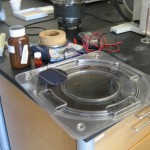Seeing is believing. Light has always perplexed humans and presents a puzzling contradiction about perception. I think perception is a topic full of gray areas. It has been proven that light is both a particle and a wave, a concept that is still rather difficult to completely comprehend. And then light also is necessary in order for us to see color, another topic of intrigue. Personally, I am really interested in color and coordination and asthetics. It’s always important to be matching! But seriously now, I thought it was really cool how color and thus our perception change due to the light. Claude Monet was an artist who proved this idea in his Haystacks paintings. Monet, being as methodical and meticulous as a scientist, painted the same haystacks at different times of he day, subtly changing the colors in the painting depending on the light.
Another art movement, pointilism, is very special in that the artist uses tiny dots to create the picture. The dots, which can be many different colors, provide a sort of color texture (not sure if that’s the correct terminology, but for lack of a better term) and result in a finished painting that looks like it lacks cohesiveness from up close but is extremely detailed from a view 10 feet away. Truthfully, the last time I saw a piece of pointilist art, I got a headache just from standing 1 foot away, and can personally attest to the fact that the paintings look better from afar. Just another optical illusion due to light and perception, I suppose.
As for the science aspect of today’s activities, we visited some labs, most notably, a lab which focused on solar materials. Harnessing and using solar energy would be such a great way to power the world. Of course, I bet the design of solar cells could be perfected in order to not only cut costs but also to make the solar cells more efficient. Another scientific idea regarding light was the Red Tides of the phytoplankton Dinoflagellate could also provide some form of energy. However, this bio-illumination must be stored somehow, and the phytoplankton must be agitated in order for them to glow, but perhaps in the future, we can find ways to take advantage of yet another source of energy from light.
Although we can only see the visible light, which is such a small part of the spectrum, I am amazed at the bright and vibrant colors of life. I wonder what it was like back in the 70’s.
http://serc.carleton.edu/microbelife/topics/redtide/
http://www.eia.doe.gov/kids/energyfacts/sources/renewable/solar.html
http://www.sciencedaily.com/news/matter_energy/solar_energy/
http://www.solgel.com/educational/glossary.htm
http://entertainment.howstuffworks.com/claude-monet-paintings-1889-18943.htm


